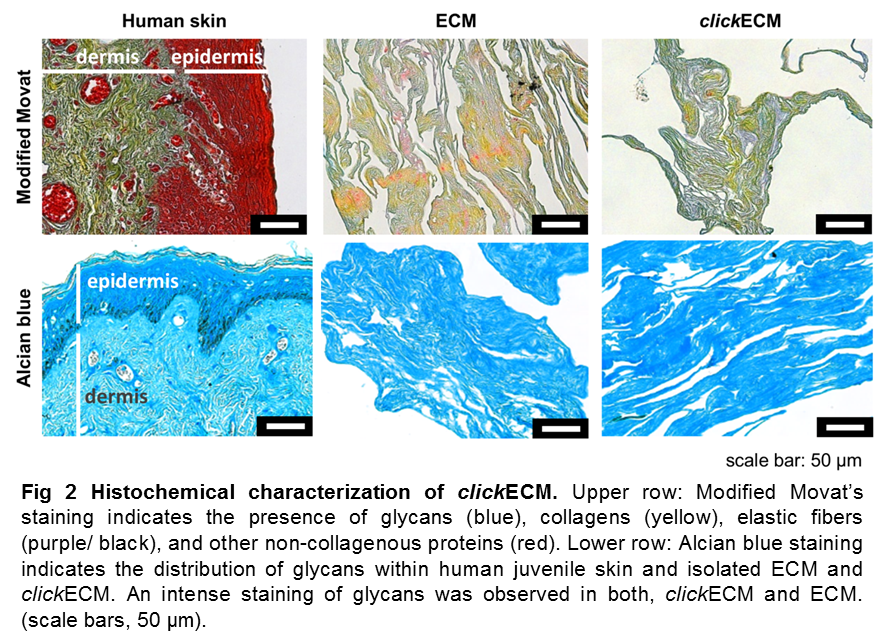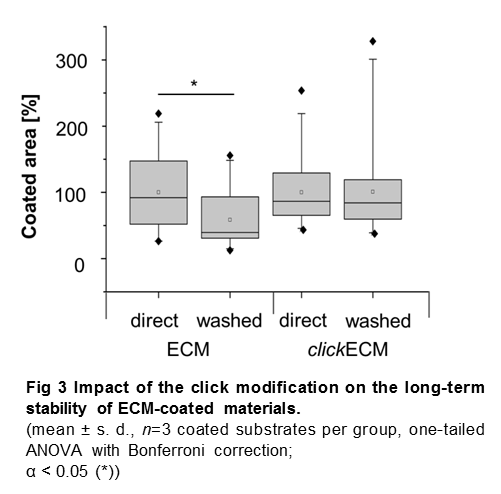The extracellular matrix (ECM) is a complex network of biomolecules that surround the cells in a human tissue. Primary cells are capable of producing an ECM in vitro which can be isolated after several days of culture[1]. Due to the high biological activity, different types of ECM are able to promote cell adhesion, proliferation, and differentiation in a tissue specific manner[2]. Because of its diverse functions, the isolated ECM is a promising coating material for the use in tissue engineering and regenerative medicine. However, a major limitation of physisorbed ECM coatings is the lack of mechanical stability (especially under physiological conditions) as no covalent linkages are formed[3]. To overcome this limitation our approach was to covalently immobilize the human ECM on artificial surfaces. Therefore, we performed metabolic oligosaccharide engineering (MOE) to introduce click groups into the glycan structures of the ECM. Here we demonstrate that this method is suitable to fabricate a “clickable” human ECM (clickECM) which can be covalently immobilized on alkyne-functionalized artificial surfaces via copper-free click reaction[4] (Fig. 1).
We cultured primary human dermal fibroblasts over a period of six days to generate a human dermal ECM. By treating the cells with an azide-modified monosaccharide (Ac4GalNAz) we were able to introduce click functionalities into the glycans of the ECM. Histochemical and immunofluorescence analysis were performed to characterize the biological composition of clickECM in comparison with untreated ECM and human skin dermis. Then, silicon wafers were functionalized with activated alkynes for the covalent immobilization of clickECM. Coating of unmodified ECM via physisorption served as control. The stability of these coatings was compared by calculating the percentage area covered with ECM before and after an intensive washing step in detergent-supplemented buffer. The bioactive properties of these coatings were evaluated by quantifying the cell proliferation of HaCaT cells seeded on either clickECM-coated or uncoated glass substrates.
We could for the first time show that MOE can be used to introduce click groups into the ECM of human dermal fibroblasts. This clickECM consists of glycans, collagens, and non-collagenous proteins whereby the ratio of these biomolecules is the same in clickECM and unmodified ECM. Furthermore, this composition is comparable to human skin dermis (Fig. 2). The clickECM can be covalently immobilized on alkyne-modified surfaces resulting in a significant increase in coating stability compared to a conventional ECM coating via physisorption (Fig. 3). Cell proliferation of HaCaT cells was significantly enhanced on the clickECM-coated surfaces compared to uncoated glass substrates. These results demonstrate that the covalent immobilization mediates a high stability while preserving the high biological activity of the human dermal ECM.
We propose that clickECM is a promising coating technology to generate long-term stable coatings with high biological complexity. In future, this could be used to enhance the ingrowth of medical implants. By using autologous cells to generate a personalized clickECM coating, the risk of implant failure would be minimized.



References:
[1] Fitzpatrick, L. E. & McDevitt, T. C. Cell-derived matrices for tissue engineering and regenerative medicine applications. Biomater. Sci. 3, 12-24 (2015).
[2] Lu, H. et al. Cultured cell-derived extracellular matrix scaffolds for tissue engineering. Biomaterials 32, 9658-9666, (2011).
[3] Goodman, S. B., Yao, Z. Y., Keeney, M. & Yang, F. The future of biologic coatings for orthopaedic implants. Biomaterials 34, 3174-3183 (2013).
[4] Kolb, H. C., Finn, M. G. & Sharpless, K. B. Click chemistry: Diverse chemical function from a few good reactions. Angew. Chem. Int. Ed. Engl. 40, 2004-2021 (2001).